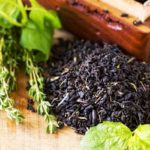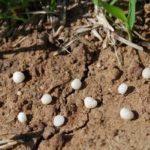Vermicompost is an ideal organic fertilizer for garden and flower crops, saturated with by-products of the life activity of red earthworms - their intestinal calculi. Liquid biohumus is used mainly for young seedlings of vegetable crops and potted plants, dry - for fertilizing depleted soil in open beds. How to use fertilizer and are there any restrictions on its use?
What is vermicompost and how to use it?
Soils rich in red worms have always been valued by gardeners.Almost every plot of experienced summer residents has a secluded corner with black soil, where liquid slops are drained and mowed dead wood is dumped - the so-called compost heap, which has been rotting for years. This type of fertilizer cannot be called a full-fledged vermicompost, but even the use of this “folk” prototype has a significant effect on productivity.
Vermicompost (vermicompost) in its pure form is a growth stimulator rich in microelements and nutrients, which was originally simple chernozem. The impact of vermicompost on vegetable and garden crops is difficult to overestimate:
- acceleration of plant growth;
- increasing the resistance of seedlings to diseases and pests;
- development of resistance to toxic poisoning;
- increased flowering;
- promoting the formation of large and healthy fruits.
It is better not to use dry vermicompost, which will be discussed, for indoor flowers, since well-fed soil fertilized with organic matter attracts flying insects, and eliminating this scourge is not easy. But with open ground it’s the other way around - the more vermicompost in the garden, the better, and there are no exceptions, because the rates for applying valuable fertilizer are limited only by the lower level.
The approximate minimum volume of this fertilizer per plant (or per hole) corresponds to the following values:
- for potatoes – 250 g;
- for strawberries – 200 g;
- for tomatoes – 180 g.
Organic fertilizer is added directly when planting a crop during the digging period or before serious watering, when the soil is not yet very compacted. If the calculation is made for the area of soil treated with vermicompost, and not for the number of plants, then for a vegetable garden with an area of 10 m2, you will need about 6 kg of fertilizer in granules.
Is there a difference in using organic fertilizers - humus or manure - which is better and which should be avoided?
- vermicompost is safer for young plants and is especially recommended for seedlings, while manure can burn seedlings;
- in the saturated environment of manure there are a lot of weed seeds, and in the case of vermicompost, this issue is controlled at the production stage;
- manure, like humus, contains a large number of bacteria that can negatively affect the health of the gardener, and vermicompost completely lacks harmful flora and contains about 100 types of microorganisms that cannot harm humans.
The principle of observing safety measures with vermicompost is the same as when working with chernozem. It is advisable to prepare rubberized gloves, and after carrying out manipulations at the dacha, wash your hands well under running water.
Vermicompost in liquid form
Liquefied vermicompost is obtained from the same dry, saturated substance, so it contains the beneficial properties of a granular concentrate, but at the same time, it is much more easily absorbed by plant roots. Liquid vermicompost is considered adapted to the most important needs of plants - its composition is balanced to tenths of a percentage of the main elements. The ash content of the prepared vermicompost is within 4%, organic matter – 60%, humins – about 30%.
The use of liquid vermicompost extends to feeding seed material. For half a kilogram of seeds you only need a glass of fertilizer solution, which should be diluted with water in a concentration of 1:20, and only then immerse the seeds in it. The shortest soaking period is given to tubers and bulbs - about 20 minutes, the longest (up to one and a half days) - to the seeds of spicy greens, watermelon and melon, some flower crops (nasturtiums, calendula, petunia). For 12-16 hours, you can immerse garlic, radish, radish or lettuce seeds in a solution of liquid vermicompost. About 4-6 hours are needed for soybeans and legumes to be affected by the fertilizer, 1 hour for any citrus.
However, the main purpose of the extract from vermicompost remains fertilizing, prepared in accordance with the needs of the crop and introduced directly into the soil. The general existing norms for diluting vermicompost are 1:10, but this indicator is considered relative and should be reviewed for each case of using fertilizer.
Instructions for using vermicompost are as follows:
- for feeding all types of spicy herbs and onions, dilute 200 ml liquid fertilizer (vermicompost) per 10 liters of water, once every 7 days;
- for berry crops, the volume of concentrated vermicompost is 50 ml per 10 liters of water, once every 7–10 days;
- tomatoes, cucumbers, zucchini and most types of other vegetables need to be watered with a standard 10% vermicompost solution;
- for citrus fruits and representatives of the grape family, as well as for all types of ornamental garden plants, prepare a 15% fertilizer solution, which is used to cultivate the soil twice a month.
The above fertilizer rates are suitable for adult plants, but for seedlings, the concentration of the prepared vermicompost solution is halved.
How to make vermicompost at home?
Natural fertilizer vermicompost, which meets all standards for compliance with a pure product, is very expensive.In addition, by analyzing customer reviews, we can conclude that the quality of purchased vermicompost cannot be checked under domestic conditions. The summer resident will have to rely on the honesty of the manufacturer, and this aspect is quite controversial. There is another option - to prepare vermicompost with your own hands and not depend on the random factors of assembly line production.
Algorithm for homemade vermicompost:
- a sufficient amount of food waste - various peelings, dry bread scraps - should first be ground to a mushy state, and then thoroughly dried, laid out on a layer of wood shavings;
- in a box 50 cm high, with drainage holes at the bottom and in the lid, add 3–5 cm of soil and lay out red worms;
- mix the dried organic pulp with soil 1:2 in a separate container, and twice a month add portions of the mixture to the box with worms, providing them with a food supply;
- Once every two weeks, the soil with worms can be watered with slightly warmed water.
After about 5 months, the box will be full - the worms will need to be moved to another place, and you already know how to use ready-made vermicompost.
There are other technologies for preparing vermicompost, in particular horse vermicompost, using ready-made compost based on horse manure. However, at home, it is quite difficult to repeat the methods of making fertilizers of this order yourself.
Not all worms can be used to prepare vermicompost - this is the reason for the different effect that fertilizer has on plants. Two types of annelids are considered ideal: Californian and earthworms..
The use of vermicompost is justified in any type of gardening activity, especially in cases where the use of other types of fertilizer can harm plants. A huge advantage of vermicompost in a dry or liquid state is the absence of an unpleasant odor, which almost always accompanies other popular feeding mixtures. Vermicompost can be frozen and thawed several times without losing its positive qualities, and the finished fertilizer can be stored even on the glassed-in balcony of a city apartment.
























